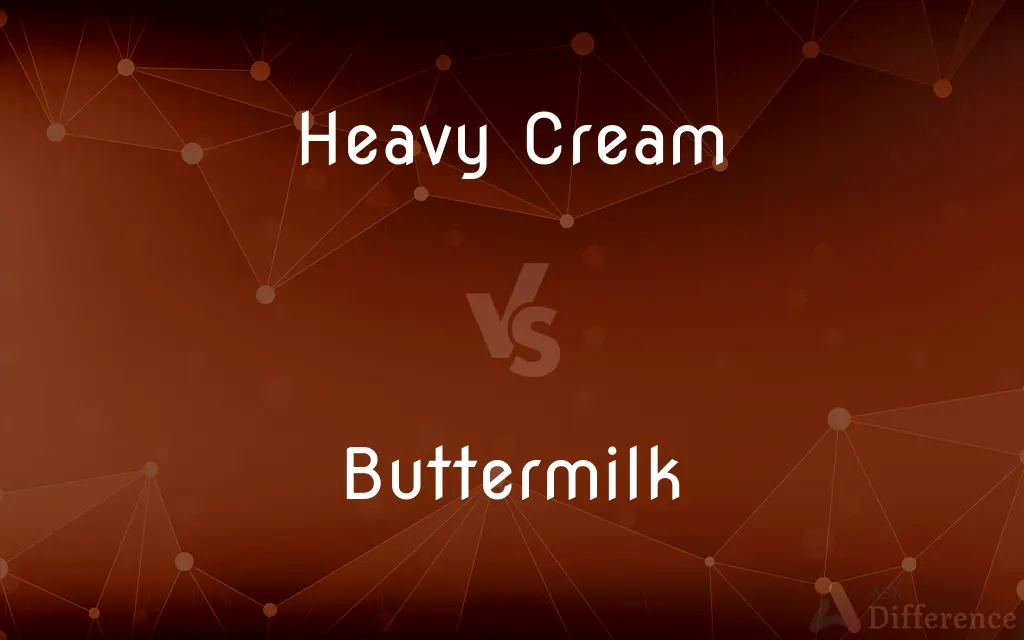Heavy Cream vs. Buttermilk — What's the Difference?
By Tayyaba Rehman — Published on December 5, 2023
Heavy Cream is a rich dairy product with high fat content, while Buttermilk is the liquid left after churning butter, often tangy.

Difference Between Heavy Cream and Buttermilk
Table of Contents
ADVERTISEMENT
Key Differences
Heavy Cream is a dairy product known for its rich and creamy texture. It's derived from the fatty portion of fresh milk and can be whipped to produce whipped cream or used as a key ingredient in various dishes. Buttermilk, on the other hand, is the tangy liquid left behind after butter has been churned. It has a unique acidic flavor and is often used in baking because its acidity can react with baking soda to help baked goods rise.
Heavy Cream, due to its fat content, can add a luxurious texture and flavor to dishes. It's commonly used in soups, sauces, and desserts. Buttermilk, with its distinct tartness, provides a tangy twist to recipes and can tenderize baked goods and pancakes, making them soft and fluffy.
Heavy Cream can also be turned into butter when it's churned. As it's churned, the fat molecules coalesce, separating from the watery portion. Once the butter is formed and removed, the remaining liquid is Buttermilk.
Heavy Cream, in culinary applications, can be used to create a velvety texture, especially in soups or sauces. Buttermilk, due to its acidity, is an excellent ingredient in marinating meats, as it helps in breaking down tough proteins and adds flavor.
Though both Heavy Cream and Buttermilk originate from milk, they serve very different purposes in cooking. While Heavy Cream enriches dishes, Buttermilk adds a pleasant tang and aids in the rising of baked goods.
ADVERTISEMENT
Comparison Chart
Origin
From the fatty portion of fresh milk.
Liquid left after churning butter.
Taste/Flavor
Rich and creamy.
Tangy and acidic.
Fat Content
High (around 36% or more).
Low.
Use in Cooking
Enriches dishes; can be whipped.
Adds tanginess; helps baked goods rise.
Texture
Thick and creamy.
Thin and slightly viscous.
Compare with Definitions
Heavy Cream
Often used in desserts and rich sauces.
The pasta sauce had a base of heavy cream and cheese.
Buttermilk
The liquid left after butter has been churned.
Buttermilk pancakes are a breakfast favorite.
Heavy Cream
It can be churned to produce butter.
By churning heavy cream, she made fresh homemade butter.
Buttermilk
It has an acidic property that reacts with baking soda.
The combination of buttermilk and baking soda makes baked goods rise.
Heavy Cream
Can be whipped to form whipped cream.
She whipped the heavy cream until stiff peaks formed.
Buttermilk
A tangy dairy liquid often used in baking.
Adding buttermilk to the cake batter ensures it's moist and fluffy.
Heavy Cream
A thick dairy product with a high fat content.
She added heavy cream to the soup to make it richer.
Buttermilk
Can be drunk straight or used as a base in smoothies.
She enjoyed a refreshing buttermilk smoothie on a hot day.
Heavy Cream
The fatty portion of milk that rises to the top.
Heavy cream is essential for making a creamy ganache.
Buttermilk
The liquid, usually either naturally soured or cultured with acid-producing bacteria, that remains after the butterfat has been removed from cream by churning.
Buttermilk
A sour milk made by culturing usually skim milk with acid-producing bacteria.
Buttermilk
The liquid left over after producing butter from full cream milk by the churning process, also called traditional buttermilk.
Buttermilk
Cultured buttermilk, a fermented dairy product produced from cow's milk, with a characteristically sour taste.
Buttermilk
The milk that remains after the butter is separated from the cream.
Buttermilk
Residue from making butter from sour raw milk; or pasteurized milk curdled by adding a culture
Buttermilk
Commonly used in marination due to its tenderizing effect.
The chicken was marinated in buttermilk for added tenderness.
Common Curiosities
Why is Buttermilk used in pancakes?
Buttermilk reacts with baking soda, making pancakes fluffier and adding a tangy flavor.
What is Heavy Cream?
Heavy Cream is the high-fat portion of milk that can be whipped or added to dishes for richness.
What is Buttermilk?
Buttermilk is the tangy liquid remaining after butter has been churned from cream.
Can I use Heavy Cream as a substitute for Buttermilk in recipes?
Not directly. But you can add lemon juice or vinegar to Heavy Cream to mimic the acidity of Buttermilk.
Can Heavy Cream be turned into butter?
Yes, by churning Heavy Cream, you can produce butter and leave behind buttermilk.
Can I whip Buttermilk like Heavy Cream?
No, Buttermilk cannot be whipped like Heavy Cream due to its low fat content.
Is Heavy Cream the same as whipping cream?
Not exactly. While both can be whipped, Heavy Cream has a slightly higher fat content than whipping cream.
Which has more fat, Heavy Cream or Buttermilk?
Heavy Cream has significantly more fat compared to Buttermilk.
What can I use if I don't have Heavy Cream for a recipe?
Depending on the recipe, you can use a mixture of milk and butter as a substitute.
Can I freeze Heavy Cream?
Yes, Heavy Cream can be frozen, but it may affect its whipping quality upon thawing.
Can I make Buttermilk from Heavy Cream?
Yes, by churning Heavy Cream into butter, the leftover liquid is Buttermilk.
Is Buttermilk sour?
Buttermilk has a tangy or sour taste due to its acidity.
Why is Buttermilk added to fried chicken recipes?
Buttermilk tenderizes the chicken and adds flavor, making it juicier and more delicious.
Can I make desserts with Buttermilk?
Absolutely! Buttermilk is often used in cakes, pies, and other desserts for its tang and moisture.
How long does Buttermilk last in the fridge?
Generally, Buttermilk can last up to 2 weeks when properly refrigerated.
Share Your Discovery

Previous Comparison
Meiosis 1 vs. Meiosis 2
Next Comparison
Transitive Verbs vs. Intransitive VerbsAuthor Spotlight
Written by
Tayyaba RehmanTayyaba Rehman is a distinguished writer, currently serving as a primary contributor to askdifference.com. As a researcher in semantics and etymology, Tayyaba's passion for the complexity of languages and their distinctions has found a perfect home on the platform. Tayyaba delves into the intricacies of language, distinguishing between commonly confused words and phrases, thereby providing clarity for readers worldwide.











































